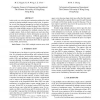Free Online Productivity Tools
i2Speak
i2Symbol
i2OCR
iTex2Img
iWeb2Print
iWeb2Shot
i2Type
iPdf2Split
iPdf2Merge
i2Bopomofo
i2Arabic
i2Style
i2Image
i2PDF
iLatex2Rtf
Sci2ools
103
Voted
ICIP
2007
IEEE
2007
IEEE
EKF Based Pose Estimation using Two Back-to-Back Stereo Pairs
In this work, we solve the pose estimation problem for robot motion by placing multiple cameras on the robot. In particular, we use four cameras arranged as two back-to-back stereo pairs combined with the Extended Kalman Filter (EKF). The reason for using multiple cameras is that the pose estimation problem is more constrained for multiple cameras than for a single camera. Back-to-back cameras are used since they provide more information. Stereo information is used in self initialization and outlier rejection. Different approaches to solve the long-sequence-drift have been suggested. Both the simulations and the real experiments show that our approach is fast, robust, and accurate.
Back-to-back Cameras | Back-to-back Stereo Pairs | Extended Kalman Filter | ICIP 2007 | Image Processing | Multiple Cameras | Pose Estimation Problem |
Related Content
| Added | 21 Oct 2009 |
| Updated | 21 Oct 2009 |
| Type | Conference |
| Year | 2007 |
| Where | ICIP |
| Authors | Mohammad Ehab Ragab, King Hong Wong, Jun Zhou Chen, Michael Ming-Yuen Chang |
Comments (0)

